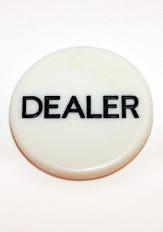|
|

Buck -
1. Slang term for the dealer button.
2. A chip with a value of one dollar.
In the middle of the nineteenth century, poker became very popular in saloons and gambling halls. Both the games that were played and
the environment that they were played in were very different than what you would find in a poker room today. In today’s game cheating
is relatively rare, and there is a framework of rules and regulations designed to protect the integrity of the game. In the middle of
the 1800’s this was not the case. Cheating was commonplace and many different schemes were developed to defraud the other players.
Both management and players were less able to defend against cheating, in all of its forms, than they are today.
Many of these cheating schemes involved manipulating the deck, either during the shuffle, or during the deal itself. Many cheaters
became masters of manipulating the deck using slight of hand techniques which could take years to master and would be nearly
impossible to detect with the naked eye. People who possessed these skills were called “card sharps.” Today they are commonly referred
to as “mechanics,” and they use a technique called the “mechanic’s grip” to manipulate the deal.
An even greater danger to the integrity of the game was the prevalent use of
marked decks. Decks were not uniformly
designed or coated with protective plastic. It was easy for players to crimp the cards or mark them with small, unnoticeable
scratches. Some players even wore specialized rings or jewelry specifically for this purpose. Many decks even had the marking hidden
in the printing on the back side, for players who knew where to look. Given the danger that cheaters posed during this time period,
players tended to be very concerned about the way their opponents conducted themselves during the game.
Players were especially concerned about the way the deck was handled both prior to and during play. In the middle of the nineteenth
century, poker dealers were pretty much non-existent. Players typically dealt their own cards. The opportunity for a player to cheat
was greatest when that player held the deck in their hand. To protect against dealer manipulation of the deck, the deal was rotated so
that each player had an equal opportunity to deal. A knife was traditionally used to indicate which player had the right to deal,
perhaps to remind people of the consequences of cheating. When the deal transferred to a new player, so did the knife. The handle of
this knife was typically made from the antler of a deer or buck, and therefore was nicknamed the “buck.”
As time passed and the culture changed, it no longer was deemed appropriate to use a weapon to demarcate game play. The knife evolved
into a disc called the dealer button, but it retained the nickname “the buck” for awhile. As the game became more regimented and
regulated, it became less and less common for players to “deal their own.” With the introduction of poker dealers on a wide scale, the
“buck” lost much of its significance. Its primary purpose, to indicate which player is dealing, no longer applied. In today’s game,
the dealer does all of the dealing, and the dealer button is simply an indicator of the order of action in flop games and in draw
games. For the most part, this term “buck” is now obsolete; you are more likely to hear the dealer button referred to as simply
“the button,” or “the dot,” rather than “the buck.”
A poker chip with a value of one dollar is also commonly referred to as a “buck.” It is common for poker chips to be referred to as
simply the dollar amount they represent. A five dollar chip could be referred to as “five bucks,” or simply “five.”
Harry Truman was an avid poker player and one can only wonder if his famous
slogan "The buck stops here" had anything to do with his passion.
Usage: Pass the Buck, One Buck To You, Tip the Dealer a Buck
Previous Poker Term: Bubble
Next Poker Term: Bullets |
|









